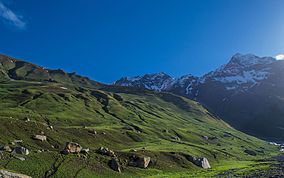| Pin Valley National Park | |
|---|---|
 | |
| Nearest town | Kaza |
| Coordinates | 32°00′N 77°53′E / 32.00°N 77.88°E |
| Established | 1958 |
Pin Valley National Park is a National park of India located in the Spiti Valley in the Lahaul and Spiti district, in the state of Himachal Pradesh. It is located in far northern India. It is part of Cold Desert (biosphere reserve).
History
[edit]Steeped in historical and present day Buddhist Tibetan culture, the area has many Tibetan Buddhist influences, evident architecturally in monasteries and stupas, and in the daily living of its residents and lamas.
Pin Valley National Park, with an area of 675 square kilometres (261 sq mi) was established by India in 1987.[1]
Geography
[edit]The park is located in the desert habitat of the Spiti Valley, within the Cold Desert Biosphere Reserve, in the Himalayas region.[2] Spreading south of Dhankar Gompa near the Tibetan border, the park marks the border between the formerly separate districts of Lahaul and Spiti. The elevation of the park ranges from about 3,500 metres (11,500 ft) near Ka Dogri to more than 6,000 metres (20,000 ft) at its highest point.
Ecology
[edit]With its snow laden unexplored higher reaches and slopes, the Park forms a natural habitat for a number of endangered animals including the Snow Leopards[3] Siberian ibex, Bharal (Himalayan blue sheep), Red Fox, Weasel, Marten, Pika and others.[4]
Flora and fauna
[edit]
Because of the park's high altitude and extreme temperatures, the vegetation density is sparse, consisting mostly of alpine trees and groves of Himalayan cedar (Cedrus deodara). In summer, birds such as the Himalayan snowcock, chukar partridge, snow partridge, finches and choughs flourish in the park.
Medicinal Plants
[edit]Some plants within the park's alpine habitats have significant medicinal properties. Twenty-two rare and endangered medicinal plant species, have been discovered in and around Pin Valley National Park, which are distributed over 10 different habitat types.[5] Aconitum rotundifolium, Arnebia euchroma, Ephedra gerardiana, Ferula jaeschkeana, Hyoscymus niger are the threatened but medicinally important plants occur in this national park.[6]
See also
[edit]References
[edit]- ^ National Parks (December 2019). "List of National Parks (As on December, 2019)". ENVIS Centre on Wildlife & Protected Areas. Retrieved 15 September 2020.
- ^ Tourism, Lahaul & Spiti District, Himachal Pradesh, India
- ^ "Snow Leopards Sighting In Spiti & Pin valley". Raacho Trekkers.
- ^ "Pin Valley National Park » Naparks". 20 April 2024. Retrieved 8 August 2024.
- ^ Kala, Chandra Prakash 2000. Status and conservation of rare and endangered medicinal plants in the Indian trans-Himalaya. Biological Conservation, 93: 371-379.
- ^ Kala, Chandra Prakash 2005; Indigenous uses, population density, and conservation of threatened medicinal plants in protected areas of the India. Conservation Biology, 19 (2): 368-378.
